Definition of These Marketing Steps
- Identification and definition of the marketing problem.
- Development and design of the marketing research plan.
- Collection of data that is specific to the identified marketing problem.
- Data analysis and reporting of relevant findings (Pride et al., 2017).
- Resolution of the marketing problem using established findings.
Changing dynamics in the target markets compel organizations to undertake constant marketing of their products and services. The first step entails the identification of a marketing problem that an organization experiences in the target market. The development and design of the marketing research plan form the second step. In the third step, once market researchers identify the research problem and develop a strategy of collecting data, they undertake a comprehensive data collection. The fourth step involves the analysis of collected data to provide accurate information about the problem and the target market (Pride et al., 2017). Ultimately, the fifth step constitutes a critical examination of the findings to derive effective strategic solutions to the current problem.
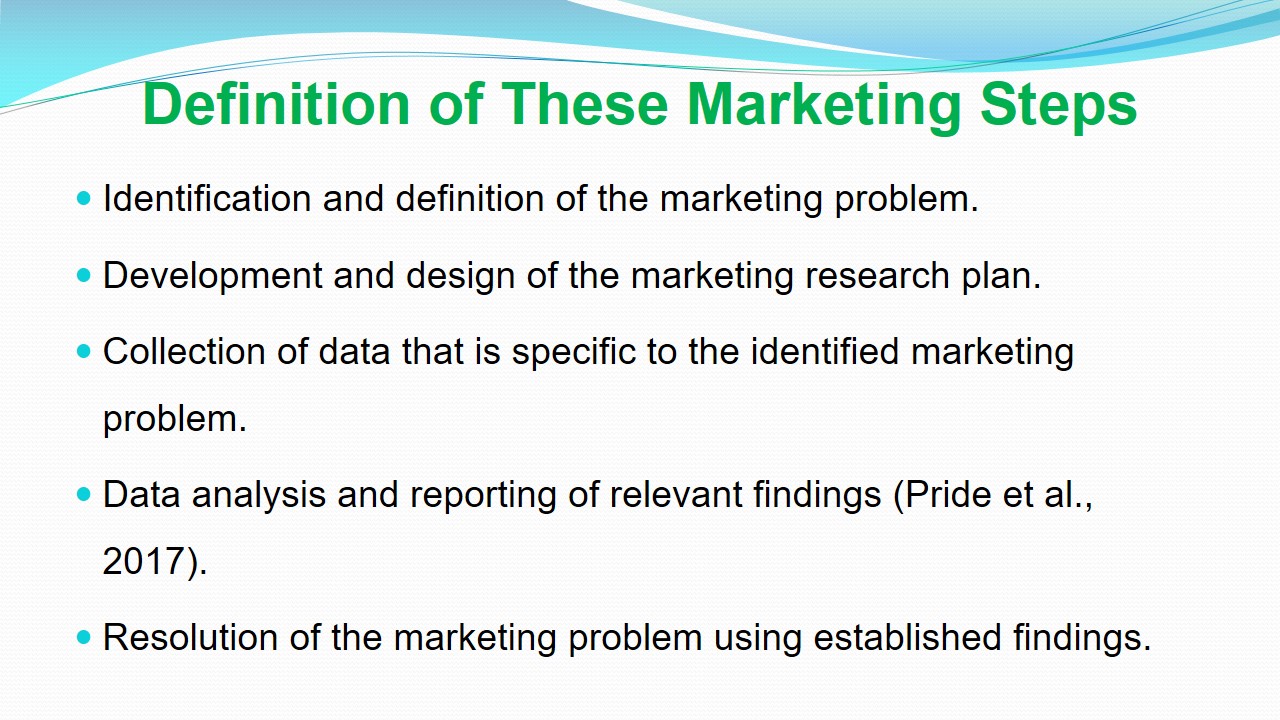
Importance of Research in Marketing
- Enables organizations to identify and understand scope of problems they experience.
- Permits collection of valid and accurate information about markets (Pride et al., 2017).
- Allows organizations to make evidence-based decisions in their operations and activities.
- Promotes the identification of avenues and opportunities for organizations to grow and develop in competitive markets.
Research in marketing has numerous benefits related to the growth and development of organizations. Research enables organizations to understand the scope of their problems so that they can develop effective interventions. In the research process, the collection and analysis of both primary and secondary data generate valid and accurate information, which reflects the market status of organizations (Pride et al., 2017). Findings from research sanction organizations to make evidence-based decisions about their growth and development. Research findings aid in the identification of avenues and opportunities for organizations to grow and develop in competitive markets.
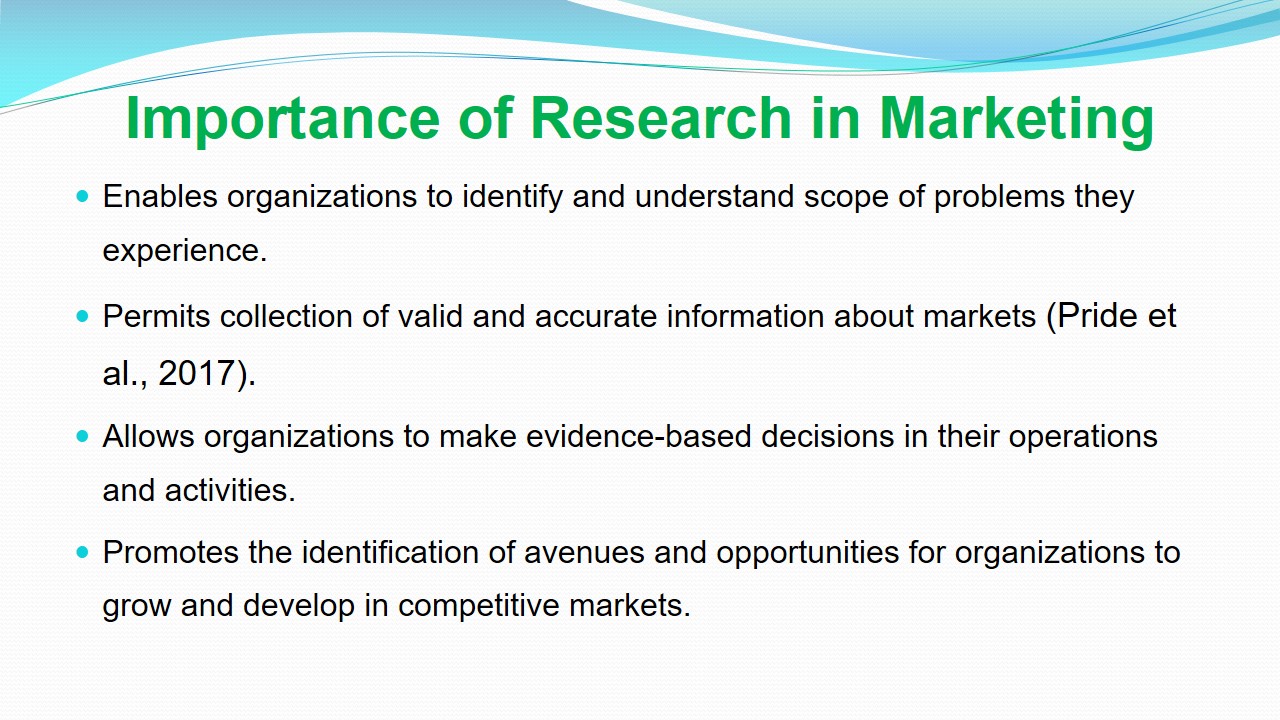
Implementation of Each Step
Step 1: Definition of the Problem
- It entails identification of the context and scope of the problem that marketing can solve.
- The problem of the charity organization is the declining number of new and repeat members.
- The formulation of research objectives and questions aid in the identification and description of the marketing problem.
- Questions should target the nature of marketing environment and demographics of customers.
Definition of the research problem is the first and critical step in the marketing research approach. It entails the identification of the context and scope of the problem that marketing can solve. In this case, the problem of the charitable organization is the declining number of new and repeat members, which requires an urgent solution to reverse the diminishing growth. A practical implementation of this step needs the identification and description of the problem. The formulation of research objectives and questions aid in the identification and description of the marketing problem. Questions should target the nature of the marketing environment and demographics of customers.
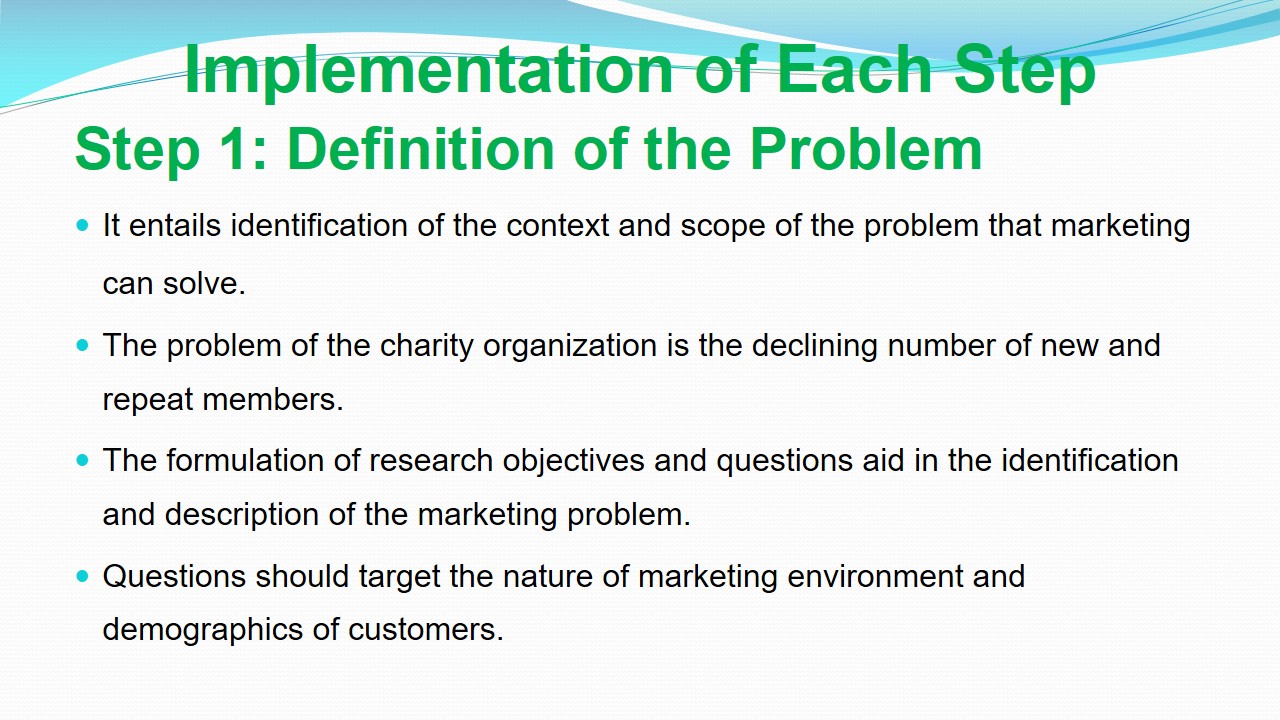
Step 2: Development of Research Plan
- The scope and nature of the problem determine the development of research plan.
- Given that the problem of the charity organization relates to the declining membership of new and repeat customers, interview is an appropriate method of collecting data from previous, current, and new customers.
- Interviews have a high response rate, collect detailed information, and allow researchers to probe respondents (Pride & Ferrell, 2015).
- Formulation of interview questions that inquiry about needs, interests, and objectives of target customers in supporting charity organizations.
The development of the research plan enables the collection of accurate and valid data that capture the problem. The scope and nature of the problem determine the development of a research plan. In the development of the research plan, marketing managers employ methods of data collection, such as interviews, surveys, observations, and focus groups. Given that the problem of the charitable organization relates to the declining membership of new and repeat customers, an interview is an appropriate method of collecting data from previous, current, and new customers. Advantages of interviews are that they have a high response rate, collect detailed information, and allow researchers to probe respondents (Pride & Ferrell, 2015). Thus, as a marketing manager, I would formulate interview questions that inquire about needs, interests, and objectives of current and potential customers in supporting charitable organizations.

Step 3: Collection of Data
- Data collection determines accuracy and validity of findings.
- Target individuals and managers of organizations who are the potential customers.
- Give ample time to each respondent during interviewing and record their responses accurately.
- Collect both qualitative and quantitative data using open-ended and closed-ended questions.
- Limit the effect of bias by asking direct questions, upholding a neutral stance during probe, and avoiding suggestive questions.
The collection of data is an essential step in the research marketing approach because it determines the accuracy and validity of findings. Using the interview as a method of collecting data, the research would target individuals and managers of organizations who are the potential customers. Each respondent would have ample time to answer interview questions and permit recording of responses for further analysis. The interview would collect both qualitative and quantitative data using open-ended and closed-ended questions. To limit the effect of bias, the marketing manager would ask direct questions, uphold a neutral stance during the probe, and avoid intriguing questions.
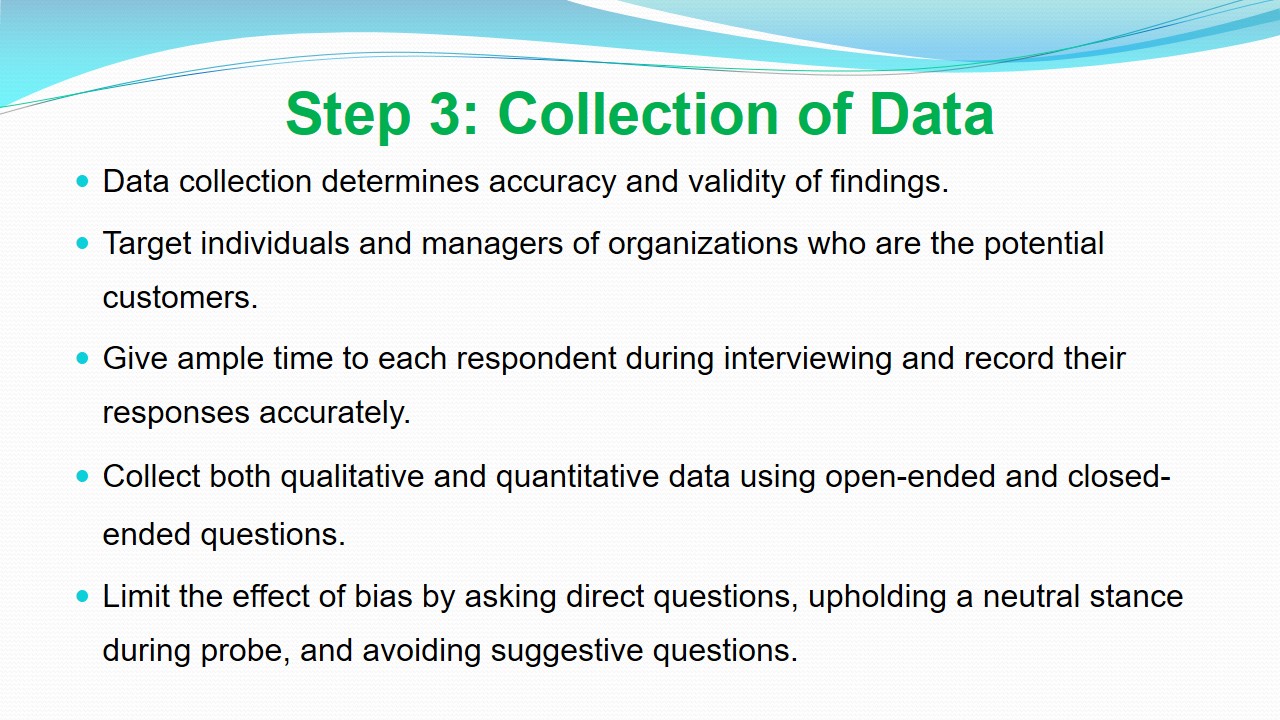
Step 4: Data Analysis and Reporting
- The aim of the data analysis is to establish patterns and trends of data, which give meaningful information.
- Descriptive and inferential statistics apply in the analysis of quantitative data, whereas thematic analysis is appropriate in the analysis of qualitative data.
- Accurate reporting of findings is dependent on methods of data analysis and the manner of interpreting results.
- Hypothesis testing of quantitative data gives accurate and valid findings.
Data analysis is a way of converting raw data collected into findings that the research targeted. The data analysis aims to establish patterns and trends of data, which give meaningful information about the marketing environment and customers. Descriptive and inferential statistics apply in the analysis of quantitative data, whereas thematic analysis is appropriate in the analysis of qualitative data. Accurate reporting of findings is dependent on methods of data analysis and the manner of interpreting results. In the case of quantitative data, hypothesis testing gives accurate and valid findings that aid in the resolution of the marketing problem.
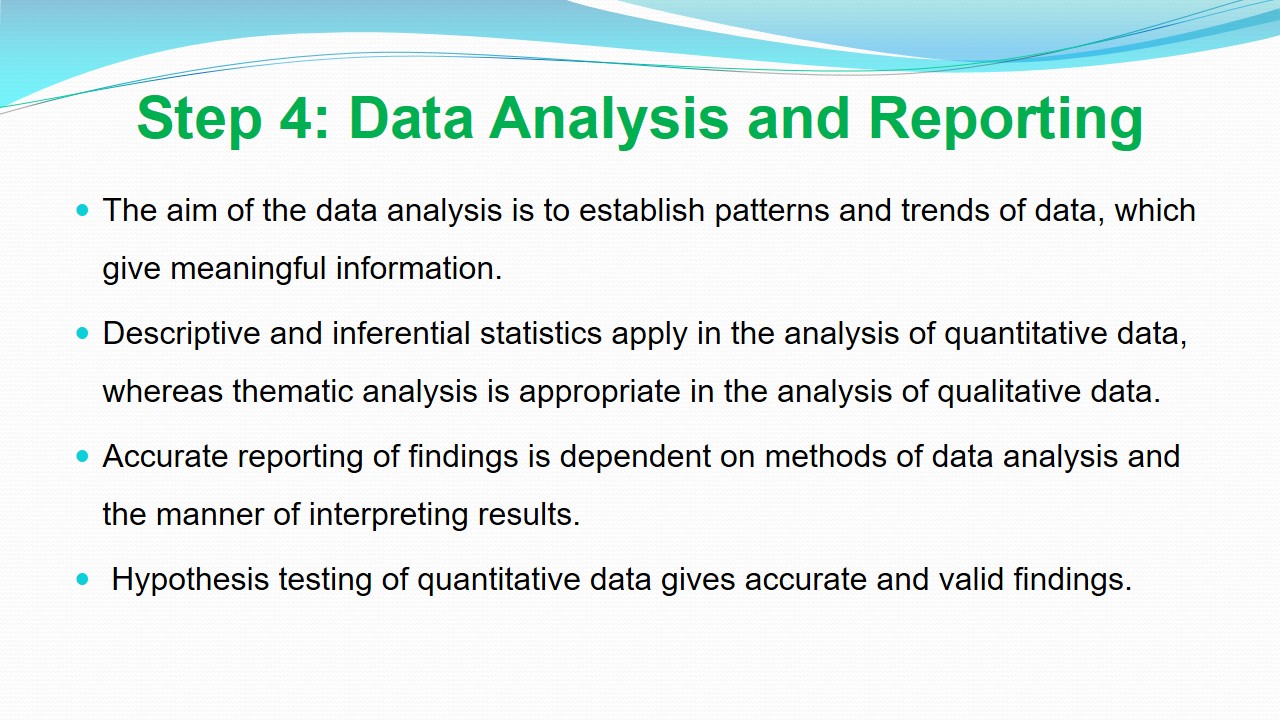
Step 5: Resolution of the Problem
- Resolution of the marketing problem is the final step in the marketing research approach.
- Since the research objectives aim at addressing the problem, the analysis of collected data provide accurate and valid findings.
- The identification of factors that decrease membership would enable the marketing manager to devise effective solutions.
- Consideration of these factors in the new marketing campaign would enable the charity organization to increase its membership.
Resolution of the marketing problem is the final step in the marketing research approach. Since the research objectives aim at addressing the problem, the analysis of the collected data provides accurate and valid findings. In this case, the findings would indicate factors that cause repeat and new members to decline in the charitable organization. The identification of these factors would enable the marketing manager to devise concrete solutions. Therefore, consideration of these factors in the new marketing campaign would enable the charitable organization to increase its membership through the retention and recruitment of new ones.
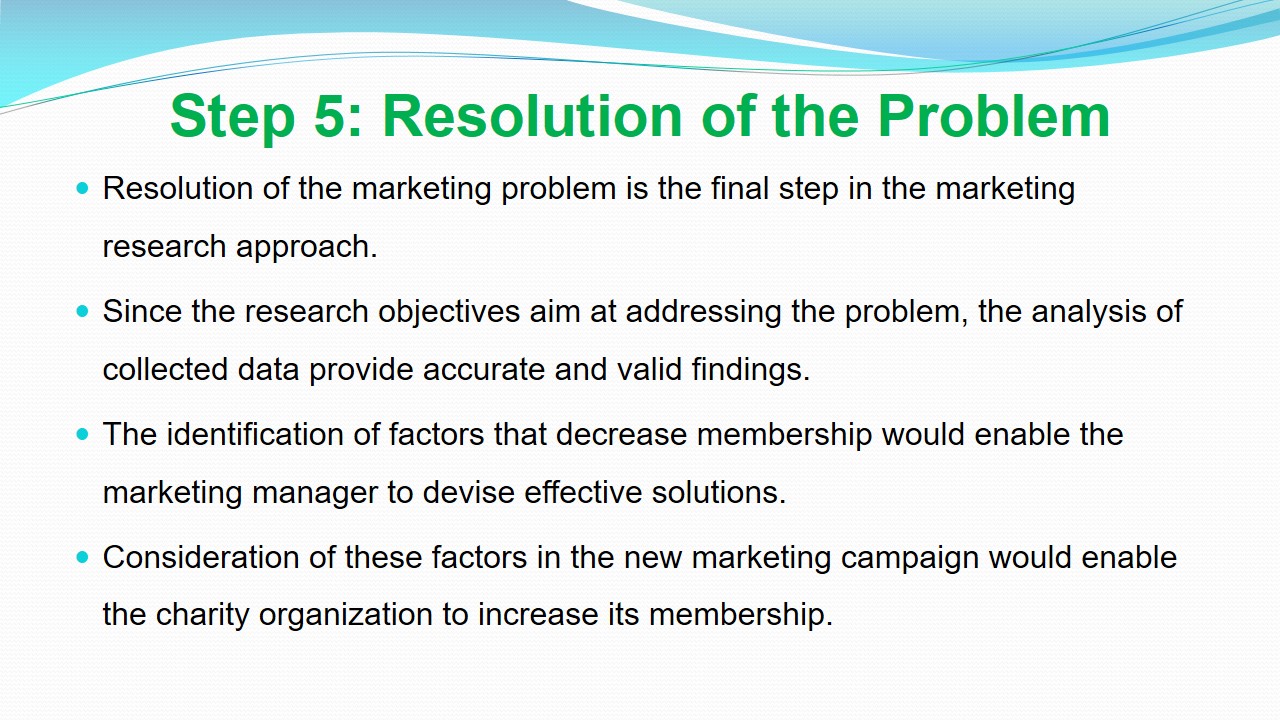
Description of Target Market
- Profit-making companies because they undertake corporate social responsibilities in their respective jurisdictions.
- Religious bodies belonging to major religions, such as Christianity, Islam, Buddhism, and Hinduism, are target customers for they often participate in charity activities.
- Individuals also constitute potential customers in the target market because they are integral members of society.
- Effective research methods are surveys, interviews, and focus groups.
The target market of the charitable organization comprises of profit-making companies, religious bodies, and individuals. Given that profit-making companies undertake corporate social responsibilities in their respective jurisdictions, they form potential customers to the charitable organization. Religious bodies belonging to major religions, such as Christianity, Islam, Buddhism, and Hinduism, are target customers for they often participate in charity activities. Individuals also constitute potential customers in the target market because they are integral members of society who determine involvement in charity work. Effective research methods that could be used to identify organizations, religious bodies, and individuals are surveys, interviews, and focus groups.
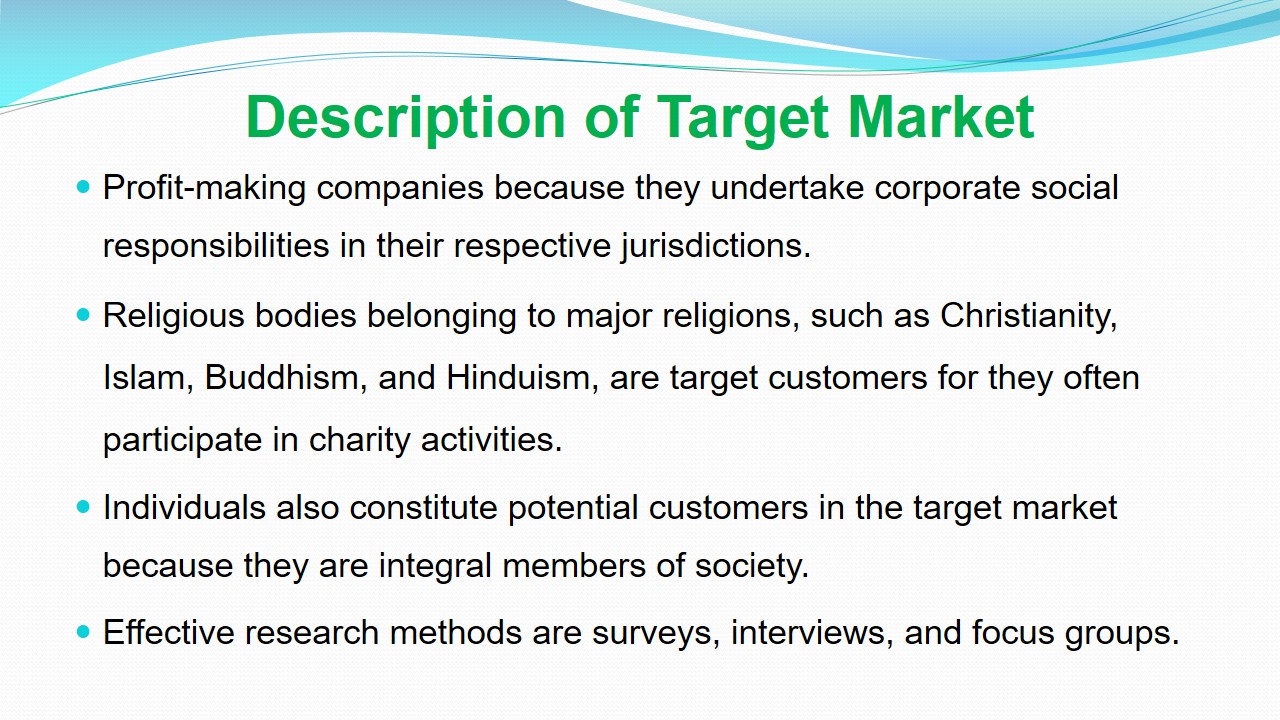
Service Differentiation
- Differentiation is a marketing approach that customizes and creates diverse products to satisfy varied needs of customers.
- Target market comprises profit-making organizations, religious bodies, and individuals as target groups.
- As potential customers in the target groups have dissimilar abilities of donating, differentiation would enable the charitable organization have varied memberships.
- Differentiation would classify donors into large, medium, and small donors.
Differentiation is a marketing approach that organizations apply to customize and create diverse products to satisfy varied needs of customers. The analysis of the target market indicates that it comprises of profit-making organizations, religious bodies, and individuals. As these potential customers have unique abilities to donate, differentiation would enable the charitable organization to have different memberships. In this case, differentiation classifies the nature of donations according to the target groups. Based on their abilities to donate, the charitable organization would classify profit-making organizations, religious bodies, and individuals as large, medium, and small donors, respectively. This method of differentiation allows diverse customers to participate and make contributions in line with their abilities.
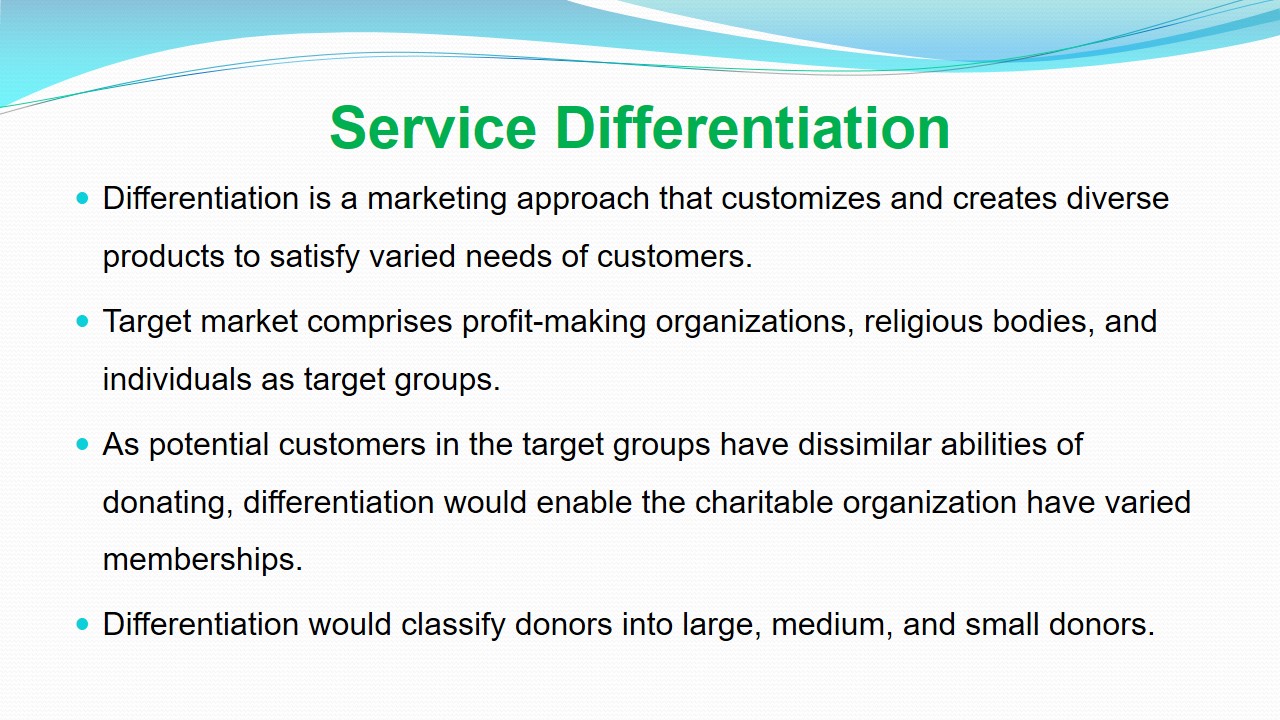
Importance of Differentiation
- Differentiation would strengthen the competitiveness of the charitable organization in its market (Chew, 2017).
- By targeting profit-making organizations, the charitable organization increase its membership and donations significantly.
- Penetration and expansion into religious bodies would increase recruitment and retention of new members.
- The recruitment of individuals encourages awareness of the charitable organization and promotes the culture of charity.
Differentiation would strengthen the competitiveness of the charitable organization in its market. According to Chew (2017), differentiation is a powerful marketing strategy that enables organizations to penetrate, create, and sustain a lucrative niche in disruptive markets. By targeting profit-making organizations, the charitable organization does not only increase its membership but also its donations significantly. Profit-making organizations are large donors for they make huge profits and participate in corporate social responsibilities. Penetration and expansion into religious bodies would increase the recruitment and retention of new members. Moreover, the recruitment of individuals encourages awareness of the charitable organization and promotes the culture of charity. Overall, individuals who have leadership roles in various organizations and religious bodies would influence charitable decisions.
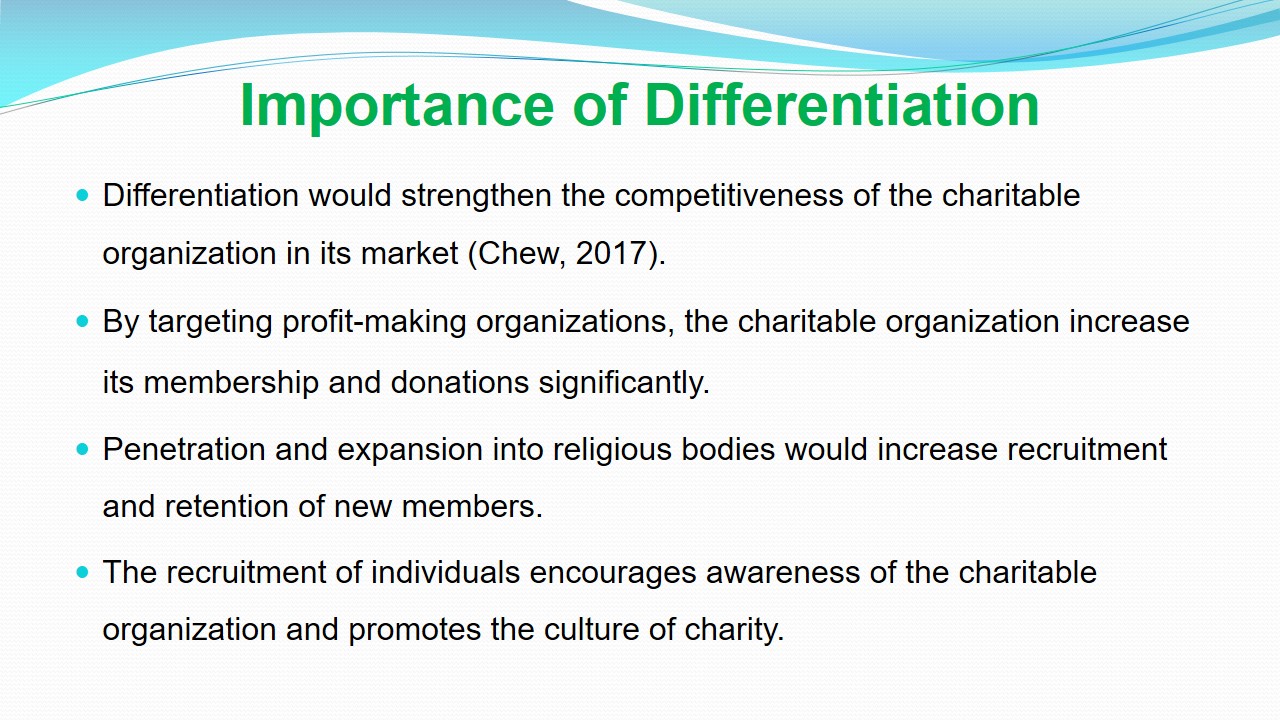
References
Chew, W. (2017). Differentiation: How to win in a disruptive market. Singapore, Malaysia: Write Editions.
Pride, W. M., & Ferrell, O. C. (2015). Marketing 2016 (18th ed.). New York, NY: Cengage Learning.
Pride, W. M., Ferrell, O. C., Lukas, B. A., Schembri, S., Niininen, O., & Casidy, R. (2017). Marketing principles. New York, NY: Cengage Learning.